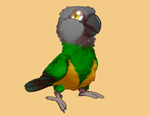 Kili
Type: Senegal Parrot
Genus: Poicephalus
Species: Senegalus
Subspecies: Mesotypus
Sex: Female
Weight: 120 grams
Height: 9 inches
Age: 17 years, 5 months
|
 Truman
Type: Cape Parrot
Genus: Poicephalus
Species:Robustus
Subspecies: Fuscicollis
Sex: Male
Weight: 330 grams
Height: 13 inches
Age: 15 years, 9 months
|
 Rachel
Type: Blue & Gold Macaw
Genus: Ara
Species:ararauna
Sex: Female
Weight: 850 grams
Height: 26 inches
Age: 13 years, 5 months
|
List of Common Parrots:
Parakeets:
Budgerigar (Budgie)
Alexandrine Parakeet
African Ringneck
Indian Ringneck
Monk Parakeet (Quaker Parrot)
Parrotlets:
Mexican Parrotlet
Green Rumped Parrotlet
Blue Winged Parrotlet
Spectacled Parrotlet
Dusky Billed Parrotlet
Pacific Parrotlet
Yellow Faced Parrotlet
Lovebirds:
Peach Faced Lovebird
Masked Lovebird
Fischer's Lovebird
Lilian's (Nyasa) Lovebird
Black Cheeked Lovebird
Madagascar Lovebird
Abyssinian Lovebird
Red Faced Lovebird
Swindern's Lovebird
Lories and Lorikeets:
Rainbow Lorikeet
Conures:
Sun Conure
Jenday Conure
Cherry Headed Conure
Blue Crowned Conure
Mitred Conure
Patagonian Conure
Green Cheeked Conure
Nanday Conure
Caiques:
Black Headed Caique
White Bellied Caique
Poicephalus Parrots:
Senegal Parrot
Meyer's Parrot
Red Bellied Parrot
Brown Headed Parrot
Jardine's Parrot
Cape Parrot
Ruppell's Parrot
Eclectus:
Eclectus Parrot
African Greys:
Congo African Grey (CAG)
Timneh African Grey (TAG)
Amazons:
Blue Fronted Amazon
Yellow Naped Amazon
Yellow Headed Amazon
Orange Winged Amazon
Yellow Crowned Amazon
Cockatoos:
Cockatiel
Galah (Rose Breasted) Cockatoo
Sulphur Crested Cockatoo
Umbrella Cockatoo
Moluccan Cockatoo
Bare Eyed Cockatoo
Goffin's Cockatoo
Macaws:
Red Shouldered (Hahn's) Macaw
Severe Macaw
Blue And Gold Macaw
Blue Throated Macaw
Military Macaw
Red Fronted Macaw
Scarlet Macaw
Green Winged Macaw
Hyacinth Macaw
Glossary of Common Parrot Terms
|
I have never dealt with a remote breeder before so I was uncertain about having a bird flown across the country. I was not only worried about the parrot's safety but also comfort during the long passage. I would like to share some of my thoughts about the concept in general and my personal experience.
First off, the good news is that the United States can be traversed by air north to south in 3 hours, east to west in 6. So if a direct non stop flight can be achieved, it should be possible in 6 hours or less. We must add at least a 1 hour drive to the airport and one hour from upon pickup. Next we can add at least 1 hour for pre-departure processing and 1 hour for post-arrival processing. So without any delays, realistically the bird can be expected to spend between 7-10 hours. However, flights that require transfers can easily add another 2-4 hours to this estimate. What I am trying to demonstrate is that a good chunk of the time the parrot needs to spend in the carrier, it isn't even in an airplane at all. Therefore, whether you are shipping across the country or a few states away, the flight time plays less of a roll.
I would recommend driving to pick up a parrot when possible but only as long as the total drive time is equal to or less than the total time required for air shipping as outlined above. You see, whether the parrot is being flown or driven, when it is bouncing around in a carrier all day, it won't eat or go about its business anyway. So you may as well search for the quickest solution possible. A 24 hour drive is definitely more stressful than a 3 hour flight (totaling about 8 hours of carrier time). Of course driving affords an element of security because you know where your bird is and can monitor its well being. When it is handed over to the airlines you can only guess at what kind of care they take. But this is where I'd like to bring my personal experience forward.
I wasn't sure what to expect when I received the carrier with Truman. I half expected to see a dead parrot nailed to the perch just inside. I was absolutely shocked to find him peering out by the door and looking excited! After being cooped up for 8 hours, I'm sure I'd be more cranky myself. I must say, it was a pleasant surprise to find how smooth everything went. The plane arrived on time (actually a few minutes early), the bird was out and handed to me within an hour of the airplane's arrival. The carrier wasn't tampered with and the bird was in good health and spirit. All and all I find that the air trip had little impact on the parrot.
Some suggestions if you are getting a parrot sent by air to you from a breeder:
-Make sure they send it out on an early flight. Not only does that give more opportunities in the case of a missed flight, earlier flights also tend to be on time.
-Have them put your name, phone number, and address on the carrier itself and the identifier for your airport.
-Watery foods like fruit are a better bet than water which can spill
-Wire tie all the doors shut and anywhere the carrier snaps together should also be zip tied.
-Always try to go direct non-stop flight because that reduces the variable of missed connection and the extra time it takes.
-Get to the airport early to pick up your bird because the cargo terminal or baggage area where you are to pick up your parrot may be difficult to find. Airports tend to have ring roads so if you miss the turn off, you may have to go all the way around the airport again until you have another chance. I went around LaGuardia 6 times I think before I finally found the proper cargo area.
-Have a second person come with you to help and in case you have to split to wait in different areas (like one to baggage and one to cargo)
-Make sure you bring ID to the airport and even alternate ID just in case.


 |
I had been contemplating names for quite some time now. In fact, with the help of many online supporters, I had compiled a list of over 250 possible name ideas. The list was broad and had many good names but none of them seemed to really click. Zuce, Zar, Ziz, and Razu were some of the top names but I was having a hard time narrowing down the right name. Then, about a week prior to receiving the bird I thought of Truman as a possible name idea. Somehow I was thinking about how the parrot would be on youtube a lot which made me think of the character Truman in the movie The Truman Show. To me the name immediately stood out both in terms of the allusion and the sound of the name.
The name Truman is really a combination of things to me. While it alludes to the Truman character from the movie, it is also about the literal meaning of the name: true-man. My hopes are to train this parrot to the greatest degree possible and make him appear as human as a feathered football sized little being can be.
I mentioned the name to many people and most agreed that it would be a good name. On the parrot forum the name Truman got the most votes which made me feel even more comfortable using it beyond just my own gut feeling. The name just clicked and seemed right from the moment I had thought of it in a far stronger way than any other name I had come up with or heard from others. This is how picking a name should work though but going through different name ideas definitely helps.
The night before picking up the parrot at the airport, I rented and watched The Truman show to get a stronger feel for the name and allusion. It definitely strengthened my decision and I absolutely adored this line when the director explains about the world Truman lives in and feel it applies to my Truman in much the same way:
We've become bored with watching actors give us phony emotions. We're tired of pyrotechnics and special effects. While the world he inhabits is in some respects counterfeit, there's nothing fake about Truman himself. No scripts, no cue cards...It isn't always Shakespeare but it's genuine. It's a life.
I firmly decided that I would not pick the name until I'd get the parrot in person but everyone around me already assumed I had picked the name. My brother would ask me "so when is Truman coming?" Other people would also assume I had picked the name beforehand. And while I didn't call him by the name until I picked him up in the airport and said "Hi Truman!" it is true that my mind was pretty much made up since I first thought of the name.
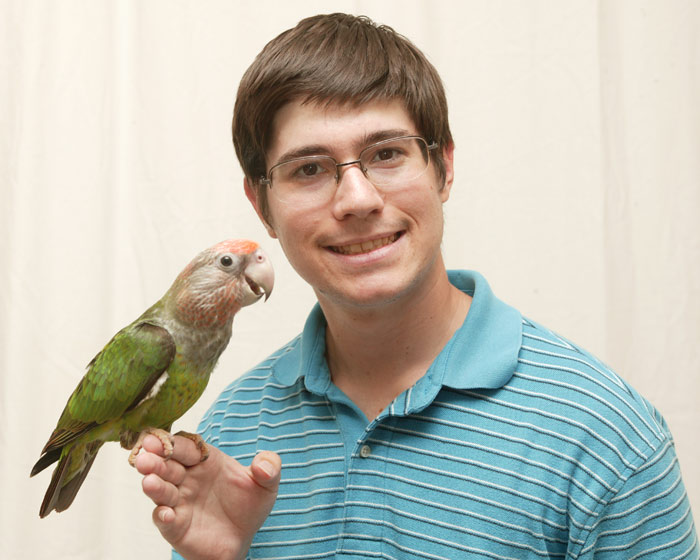
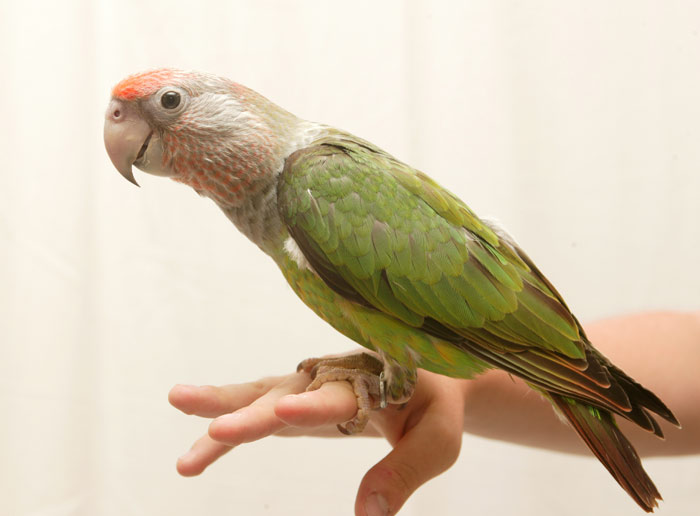 |
As I await the arrival of my new Cape Parrot, I would like to outline some of my goals with the new bird. The order is ballpark of how it would go but not a rigid sorting:
-Get parrot, let it get used to me and new surroundings
-Develop strong flock mate/trainer relationship bond
-Encourage independent play as well as social time
-Develop a daily routine that sets feeding regimes, flight time, out of cage time, and outdoor time
-Desensitize to wide array of household objects while naming each object
-Configure clicker as bridge and eventually a strong secondary reinforcement
-Teach target training through modeling rather than trial/error if possible
-Develop strongest flight recall possible (recall by visual, whistle, and name)
-Minimum dependence on food for reinforcement
-Develop strong alternative reinforcements
-Progressive taming to allow uninhibited touch of entire body
-Make minimum intrusion introduction between Kili and Cape
-Maximum comfort harness training
-Outdoor desensitization while wearing short harness
-Begin training outdoor harnessed recall
-Socialize parrot to as many people as possible both indoors and out
-Differentiate social time and focused training time
-Develop safe petting cue and method
-Reduce beaking, biting, and nipping by ignoring
-Ignore all unpleasant vocalizations and present acceptable alternative ones
-Train necessary maintenance behaviors through positive reinforcement
-Voluntary carrier training through empowerment
-Start training full trick routine
-Goal is to train each trick in the shortest and most effective manner possible
-Develop visual and verbal cues for every trick
-Take parrot on social outings, car drives, and airplane flights while still young
-Begin implementing variable ratio reinforcement on cued behaviors
-Say same words to encourage talking
-Develop special (not annoying) contact call specific for this parrot
-Combine flight and cued tricks
-Train highly complex trick behaviors to challenge parrot
-Test cognitive capabilities through challenging puzzle tricks
-Provide occasional foraging opportunities in/out of cage
-Continue flight training optimized toward outdoor freeflight
-Perfect each trick to develop best trained parrot role model
Having extensively learned trick training on Kili and Duke, I think I will be able to train the Cape more quickly and efficiently. At the same time, I would like to experiment with alternative training methods like modeling, empowerment, and differential reinforcement. I am going to make the strongest possible effort to do all training through positive reinforcement and avoid resorting to flooding, negative reinforcement, or punishment. I do know that these methods can be effective but I am curious to accept the challenge of trying to train without them.
Here are some my goals for the trainedparrot blog:
-Provide regular updates about the Cape's progress
-Post photographs/videos of every step of training the new Cape Parrot
-Write step by step articles about how I train every single trick/behavior
-Present my thoughts/opinions about parrot ownership and care
-Develop the training blog as an alternative to costly training products
-Write objectively about the good, the bad, and the ugly
-Cite outside sources where applicable
-Lead the parrot community by example
-Make all information public and hold nothing back
-Create a definitive source of parrot training knowledge from my own experience
-Eventually open the blog up to additional willing writers
-Turn training blog posts into a complete/organized training guide
Here is a progress update about the upcoming Cape Parrot. Originally I was supposed to get the older of the two babies. Jean expected the older one to end up bigger because it was born from a larger set of wild caught parents. However, as time progressed, it turned out that the younger baby not only caught up but grew bigger than the older one. The younger Cape comes from a domestic pair named Angie and Magnum. Jean said this baby not only turned out larger but also has a sweeter disposition. The older is now 295g but the younger is 315g. They are somewhere from one to two weeks apart. Jean has done the same extensive efforts with both parrots and I am currently the only paid buyer so I have the option of choosing either one. She taught both parrots to drink from a water bottle, eat the same pellets, and to wear an aviator harness. So based on everything Jean advised, as well as all the good things I've heard from someone else that bought a Cape Baby from the same breeding pair, I decided to go with the younger/larger Cape.
This Friday, Jean will be taking the Cape to her vet on my behalf. I asked her to get the vet checks for me because she has a very good vet and I don't like the one I worked with in my area. If the parrot checks out healthy before being shipped, I don't really see any need in duplicating the check afterwards. The visual inspection the vet did when I bought Kili I can so easily do myself now at this point. I'm quite confident in Jean as a breeder so the vet check is only precautionary. The vet will also take care of some final grooming and place an open band on the parrot's left (non-dominant) foot. Pending all results being good from the vet check, Jean should be shipping the Cape Parrot to me early Tuesday morning to avoid the Florida heat. Thursday is the back up day.
Here are more pictures that I just received from the breeder:







|
I finally received some pictures of my Cape Baby from the breeder so here they are. My baby is the one that is slightly older. You can tell cause it has a bit more feathers and tail coming in.
The baby Brown Necked Parrot was DNA sexed and confirmed to be a male. The breeder is in the process of weening the immature UnCape on a pellet diet of Pretty Bird and Roudybush.
I can expect the Cape baby shipped to me from Florida when it is fully weened at around 12-14 weeks old. I'll post new pictures as I get them.
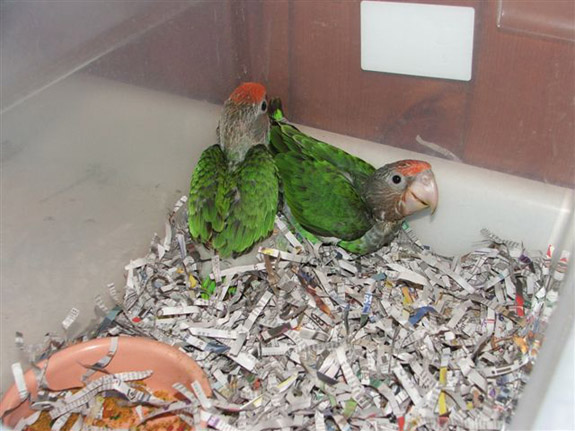
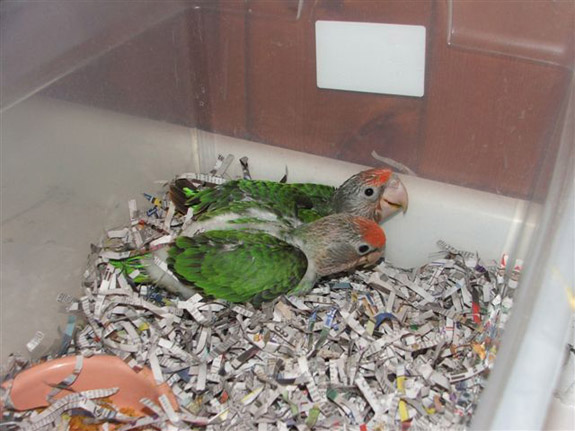
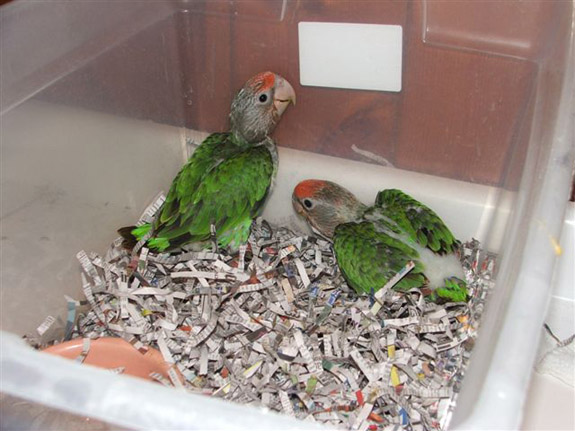
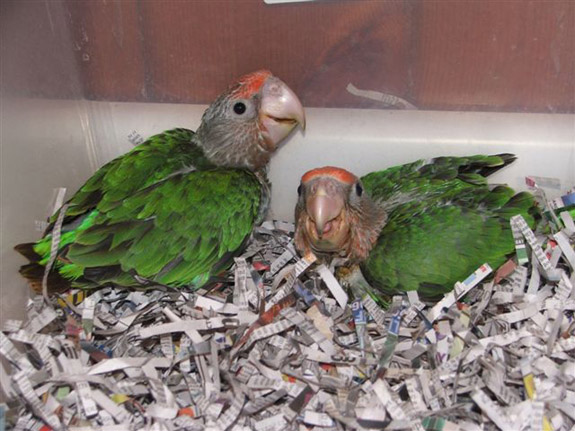 |
|

















 Older Articles
Older Articles